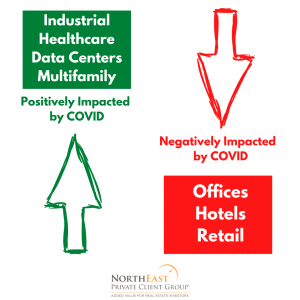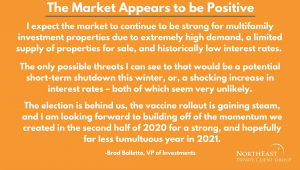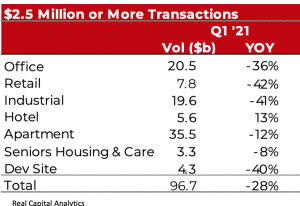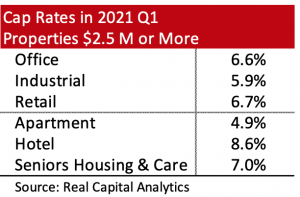February 2021
Are you wondering about the commercial real estate market – 2021? Click here to go to the mid-year commercial real estate outlook update.
As a result of the pandemic, many people have made short and long-term lifestyle changes. When the pandemic started, urban locations were hit hard, and many people fled the cities due to the dense population and reduced opportunities for social distancing. However, the attractive lifestyle a post-pandemic bustling city provides will draw some back.
The CBRE reports, “There are no indications that 2020’s decline in urban multifamily demand is permanent or there is an impending return to the hollowed-out cities of the 1970s and 1980s. Yet urban submarkets will lag in the multifamily sector’s overall recovery. Lower-density and less-expensive suburban submarkets held up remarkably well in 2020 and are positioned to lead overall market performance in 2021”.
Positive effects of COVID on the commercial real estate market – 2021
Which properties are being positively affected by COVID?
- Healthcare facilities: Hospitals were filled to max capacity during the pandemic. Along with job opportunities in the healthcare field, the demand created a need for new healthcare facilities.
- Data centers: Doctors and scientists worked overtime around the clock to create a vaccine for COVID at data centers around the country.
- Industrial real estate: Since many businesses closed, people were shopping online for their goods. Companies looked for warehouses to store products that are now sold online.
- Multifamily: Due to many people working from home, a comfortable work environment became valued by employees in suburban markets.
What was the impact on the multifamily real estate market in 2021?
Senior Financial Analyst at Northeast Private Client Group, Jacob Jordan said,
“As urban core multifamily properties have struggled with increased vacancy and collections issues throughout the past 12 months, suburban multifamily have continued to perform well. In suburban multifamily, occupancy has remained high and collections issues are very limited at the middle and top tier properties. Rent growth remains but has been limited and most owners are expecting to be able to raise rents in 2021. Demand for suburban multifamily is high, and that coupled with historically low-interest rates has resulted in increased pricing”.
There is no doubt that the first half of 2020 was difficult for investment real estate. Many submarkets of commercial real estate have been negatively impacted by the global pandemic. The multifamily submarket, however, managed to survive due to the constant need for shelter. Three out of the five largest transactions Northeast Private Client Group has ever brokered, happened in 2020.
As a brokerage firm specializing in multifamily and apartment building investments, it is clear that these types of investments tend to be recession-proof.
As market conditions improve, multifamily investment volume is expected to increase in the new year.
According to CBRE research, “U.S. multifamily investment volume will reach about $148 billion next year, lower than 2019’s record level of $191 billion but a 33% gain over the 2020 estimate of $111 billion”.
Class A multifamily investments saw the greatest struggle in 2020 and are expected to recover the slowest; whereas Class B and C multifamily investment properties have and will continue to do well.
According to Wealth Management, “Apartment managers continued to lease apartments even in the first months of the pandemic. Markets in the U.S. absorbed 71,493 apartments in second quarter. Demand for apartments strengthened through the rest of the year. Markets absorbed a net 114,000 apartments in the third quarter, one of the strongest third quarters CoStar has ever recorded in multifamily. And the fourth quarter was the strongest since 2015, based on preliminary data, says Rybczynski. The average apartment community to remain close to fully occupied in 2021 with relatively stable rents and stable collections”.
The negative effect of COVID on the commercial real estate market – 2021
Which properties are being negatively impacted by COVID?
- Offices: When the pandemic hit, many companies started working from home. It was the smartest way to ensure the safety and health of all employees. As the vaccine continues to roll out, people are returning to the office, however, many companies are adopting a hybrid work format.
- Hotels: People stopped traveling when the pandemic started. There was no business or leisure travel taking place. With the ‘all clear’ given to move about the country, the real estate outlook for the hotel category is cautiously bullish. Leisure travel has come alive as Americans resume their traditional summer vacations. Businesses, however, have been slower to authorize travel now that they know how virtual meeting will impact their business. Over time, businesses will begin to send their employees back to conferences and external meetings that will require travel and hotel stays.
- Retail: Non-essential businesses were ordered to shut down when the pandemic started. Unfortunately, this caused many business owners to have to shut their doors for good.

Commercial real estate outlook for 2021
When it comes to mixed-use retail and apartment buildings, we know that unfortunately, many retail companies went out of business in 2020. As we head into 2021, the outlook for retail real estate is looking a bit different. Orion Investment Real Estate said,
“More retailers went bankrupt in 2020 than during the Great Recession — especially department stores and apparel retailers. As brick-and-mortar retailers burn through cash reserves and consumers shop online, even more retail properties will go empty and landlords will default on their loans in the first half of 2021. Experts predict there will be 20% less retail real estate by 2025, according to the CBRE”.
Due to the influx in online shopping, investors can expect to see an increase in warehouse and storage real estate.
For those people looking to sell their building, now may be the perfect time to list.
“Looking into the commercial real estate outlook for 2021, the market appears to be positive. I expect the market to continue to be strong for multifamily investment properties due to extremely high demand, a limited supply of properties for sale and historically low-interest rates. The only possible threats I can see to that would be a potential short-term shutdown this winter or and a shocking increase in interest rates – both of which seem very unlikely. The election is behind us, the vaccine rollout is gaining steam, and I am looking forward to building off of the momentum we created in the second half of 2020 for a strong, and hopefully far less tumultuous year in 2021”.
Bradley Balletto, VP of Investment,

New: Mid-year Commercial Real Estate Outlook
Currently, the commercial real estate outlook is trending low but stable for now. Questions continue to loom about the state of the pandemic entering the fall and winter, leaving many real estate investors to wonder about the outlook for real estate for the rest of 2021.
Outlook: Q1 and Q2 Commercial Real Estate Market, 2021
As the COVID vaccine has become widely available in the United States, people are starting to get back to living their lives normally – or as normal as one can in the middle of a global pandemic. Many companies still have employees working from home, with more and more adopting the hybrid work format. As expected, commercial real estate transactions showed a decline at the beginning of 2021. Apartment rents are on the rise due to people returning to cities and the expensive housing market forcing them to continue renting.


Commercial Real Estate Outlook Market Trends to Watch
While metrics don’t tell the whole story. It’s wise to keep an eye on the trends in the real estate market in 2021. Below you can find a summary of the 2021 trends according to the NAR & Real Capital Analytics.
- Commercial sales transactions are down 28% from one year ago.
- Transactions were down across all property types except for hotel properties where acquisitions rose 13%.
- Commercial prices are recovering but still down 6%.
- As commercial prices continue to firm up, cap rates continued to decline. Apartment acquisitions had the lowest cap rate of 4.9%, followed by industrial at 5.9%.
- Hotel properties had the highest cap rates, at 8.6%.
- Office cap rates were at 6.6%.
- Leasing activity for new leases and renewals continues to fall in 2021 Q1.
- Office occupancy continues to fall while industrial occupancy rises in 2021 Q1.
- Trend towards smaller square footage, shorter-term leases, and more suburban leases.
- Trend towards repurposing vacant mall space.
- NAR commercial members expect more sales transactions in land, residential, and industrial properties.
What’s ahead: Commercial real estate outlook for 2022
“My team is positioned to have our best year ever in 2021 and I suspect the same is true for many investment sales brokers.”
-Brad Balletto, VP of Investments
The market has definitely rebounded since last year’s shutdown. Demand for investment properties is very strong. Rents have grown just about everywhere outside of a few major cities such as New York City, San Francisco, and Los Angeles. Occupancy rates are near 100%. Collections have been held and programs such as UniteCT have helped to backfill for landlords who had tenants unable to pay because of COVID, and unable to evict because of the eviction ban. The only challenge lately has been a generally low supply of available properties. However, that, coupled with all the other positives, has helped to drive pricing higher – higher even than levels pre-pandemic.
“Despite fears during the pandemic, the multifamily market has remained strong. Though last year saw limited rent growth, as we come into 21Q3, investors have been able to recoup with above-average growth in certain markets.”
-Jacob Jordan, Senior Financial Analyst
Commercial real estate is expected to recover across almost all sectors in 2022. With many areas of the United States population getting vaccinated and consumers returning to their routines and activities, as long as the COVID virus stays under control and there is no major outbreak, the commercial real estate outlook for 2022 is looking positive.

